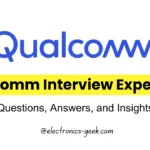Preparing for a Qualcomm hardware interview can be challenging, but getting tips and insights from students who have already been through it can make all the difference. This article shares real-life experiences and key interview questions from those who’ve sat in the interview seat for hardware roles at Qualcomm.
You can expect a comprehensive and challenging process that covers various aspects of hardware design, VLSI, digital logic, and embedded systems. Below is an in-depth account of a typical Qualcomm hardware interview experience, along with answers to common questions that may help you in your preparation.
Table of Contents
Toggle1. Questions on MTech Project:
- Answer Approach: In a Qualcomm hardware interview, you may be asked to explain your MTech project, particularly if it involves hardware design or a relevant technical area. Be prepared to discuss both the technical challenges and practical solutions, and highlight how your project aligns with the role you’re interviewing for.
2. K-map with 4 Variables & Gray Code:
- Answer: During a Qualcomm hardware interview, you could be asked to draw a 4-variable K-map for Boolean minimization and justify the use of Gray code. The main reason for using Gray code is that it minimizes errors in state transitions by ensuring that only one bit changes between consecutive values, which is important in many hardware applications like counters and state machines.
Example of 4-bit Gray code:
0000
0001
0011
0010
0110
0111
0101
0100
1100
1101
1111
1110
1010
1011
1001
1000
3. Why Low Power VLSI Design Is Important:
- Answer: A Qualcomm hardware interview may ask about the importance of low power VLSI design. The primary reasons include:
- Battery-powered devices: Low power consumption is crucial for extending battery life in mobile and IoT devices.
- Thermal management: Lower power reduces heat dissipation, which helps maintain the integrity of high-density circuits.
- Cost and Reliability: Low power designs lead to smaller form factors and more cost-effective manufacturing.
Additionally, you could mention that power-efficient designs can also improve system reliability and reduce overall operational costs.
4. Techniques for Low Power Design in VLSI:
- Answer: In a Qualcomm hardware interview, expect to discuss techniques for low power VLSI design, such as:
- Clock Gating: Disabling clocks in unused parts of the circuit.
- Power Gating: Disconnecting power from inactive blocks.
- Dynamic Voltage and Frequency Scaling (DVFS): Adjusting voltage and frequency based on workload demands.
- Multi-threshold CMOS (MTCMOS): Using different threshold voltages for different logic blocks to save power.
- Low Power Design Libraries: Utilizing standard cells optimized for low power consumption.
5. Verilog Code to Swap Two Numbers:
- Answer: A common question in a Qualcomm hardware interview is to write Verilog code for basic operations. For swapping two numbers, you can use the following code:
module swap_numbers (
input [7:0] a, b, // 8-bit inputs
output [7:0] a_out, b_out // swapped outputs
);
assign a_out = b;
assign b_out = a;
endmodule
This code demonstrates how to swap the values of two 8-bit numbers in Verilog.
6. FSM Design for Detecting Sequence “1101” (Mealy Machine):
- Answer: In a Qualcomm hardware interview, you may be asked to design an FSM (Finite State Machine) to detect a specific sequence. Here’s how you can design a Mealy machine to detect the sequence
1101:- States:
S0(Initial),S1(after ‘1’),S2(after ’11’),S3(after ‘110’),S4(after ‘1101’ – final state).
The Mealy machine ensures the output is generated as soon as the sequence is detected, making it ideal for real-time applications.
Mealy FSM Table:
State Input 1Input 0S0S1S0S1S2S0S2S1S3S3S4S0S4S4S4 - States:
7. Why Can’t We Use the Same Logic for 1101 with 4 Flip-Flops?
- Answer: In a Qualcomm hardware interview, when asked why your FSM for detecting
1101can be implemented with 2 flip-flops, whereas the alternate design requires 4 flip-flops, you should explain that the number of flip-flops corresponds to the number of states in the FSM. Using 2 flip-flops allows you to implement a more efficient, minimal-state solution.
8. Solving Real-Life Problems in Hardware (Diabetes Case Study):
- Answer: A Qualcomm hardware interview often includes questions about real-life problems and how you would address them using hardware solutions. Since your MTech project was focused on a solution related to diabetes, you could describe how you would design a wearable sensor to monitor blood glucose levels. The sensor would use low-power embedded systems to detect glucose levels and transmit the data to a smartphone or healthcare provider.
9. Restoring Divider in Digital Systems:
- Answer: In a Qualcomm hardware interview, if you mention a restoring divider in your project, be prepared to explain both the algorithm and the logic behind it. The restoring division algorithm is used for binary division, where you subtract the divisor from the remainder, and if the result is negative, you restore the previous remainder.
Key steps:
- Subtract the divisor.
- Restore if necessary.
- Repeat until the division is complete.
10. Setup and Hold Time Calculation:
- Answer: A critical question in any Qualcomm hardware interview is to calculate setup time and hold time for a flip-flop or register. Setup time is the minimum time before the clock edge that input data must be stable, while hold time is the minimum time after the clock edge that the data must remain stable.
Timing Example:
- Setup Time (T_setup) ensures that the data input is stable before the clock edge.
- Hold Time (T_hold) ensures that the data remains stable after the clock edge to avoid glitches.
Preparing for a Qualcomm Hardware Interview
Your experience in a Qualcomm hardware interview will test both your theoretical and practical knowledge. Be ready to tackle questions on topics like VLSI design, Verilog coding, FSM design, low power techniques, and timing analysis. Whether you’re asked about Gray code, restoring dividers, or real-life hardware problems, a strong understanding of hardware fundamentals and clear communication of your thought process are key.
If you focus on system-level design, digital circuits, and hardware optimizations, you’ll be well-prepared for your Qualcomm hardware interview. Don’t forget to practice with common Verilog design questions and timing analysis to ensure you’re ready for any technical challenge they throw at you!
Good luck with your Qualcomm hardware interview preparation, and remember that persistence and practice are key to success!









